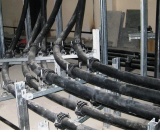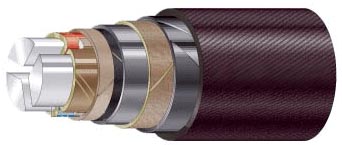Heating paper insulated cables with continuous current
 The limiting temperature of the core of paper-insulated cables with lead or aluminum sheath is determined by the following circumstances:
The limiting temperature of the core of paper-insulated cables with lead or aluminum sheath is determined by the following circumstances:
1. Durable cable paper. With a prolonged increase in temperature above the permissible value, the paper collapses, loses its mechanical strength, which leads to cable damage.
2. Inadmissibility of formation of vacuum and gas inclusions inside the cable. Heating of the cable cores is associated with an increase in the volume of the cable and an increase in the internal pressure on its lead or aluminum sheath.
The increase in pressure in the cable is mainly due to the high temperature expansion coefficient of the impregnating mass (the temperature expansion coefficient of the impregnating mass is 10-20 times higher than the temperature expansion coefficients of copper, aluminum and paper) and leads to permanent deformations of the lead sheath. As the current load decreases, the volume of the cable components decreases.
First of all, the outer layers of insulation are cooled, which leads to the depletion of the impregnating mass of the insulation layers adjacent to the cable cores. Vacuum and gas inclusions are formed. The ion bombardment of the paper and the action of active ozone in these inclusions lead to the destruction of the cable insulation.
The limiting temperature of the conductors of cables with paper insulation and laminated PVC sheaths is determined by the inadmissibility of softening of these sheaths. Permissible core temperatures of paper-insulated cables acc «Rules for the construction of electrical installations» are given in table. 1.
Table 1 Permissible temperatures of cable cores, ° C
Line voltage, kV Up to 1 6 10 20 35 Permissible temperatures of cables with lead and aluminum sheath 80 65 60 50 50 The same applies to cables with laminated PVC sheaths 65 — — — —
Power cables are laid in the ground, in the air (in channels, on the walls of buildings), in pipes, etc. Heat (separated in the cables laid in the ground, overcoming the thermal resistance of its covers, is removed from the cable surface due to the thermal conductivity of the soil .The cooling process of a cable in air is similar to the cooling process of insulated wires.
When determining the amount of heat released in the cable, energy losses in the insulating dielectric and from induced currents in protective and sealed sheaths are taken into account. Losses in armor and lead or aluminum sheaths reach practically noticeable values in single-core cables.
For cables laid in the ground, the calculated temperature is taken equal to the highest average monthly soil temperature. At a depth of 0.7 — 1.0 m, corresponding to the depth of cable laying, the temperature changes within 1 month. very small.
The permissible cable loads are according to the tables of the «Rules for electrical installation», which are compiled based on the soil temperature of + 15 ° C.
If more than one cable is laid in the trench with a clear distance of 100 — 300 mm, then the cooling conditions deteriorate and the allowable loads on the cables are reduced. When determining long-term permissible loads, redundant cables are not included in the number of adjacent cables. Standby cables are understood as normally operating unloaded cables, when they are disconnected, it is possible to transfer the full design power through the remaining cables.
At soil temperatures other than + 15 ° C, the conditions for cooling the cables change. Soil temperature corrections are made by multiplying the current loads given in Appendix 10 by correction factors.
Cables laid on the walls of buildings, in ducts (in the air), etc., have worse cooling conditions than when laid in the ground. Long-term permissible currents through cables laid in air at a temperature of + 25 ° C and correction factors for air temperature are given in PUE.
If several cables are laid in a channel or tunnel, and the ventilation ensures a constant temperature in them, then the current load, depending on the number of laid cables, is not reduced. Only air temperature correction factor is entered.When laying cables in the air, the design temperature of the environment is assumed to be equal to the temperature of the hottest day.
When a number of circumstances are combined, for example, when several cables are laid in parallel and the temperature of the soil is different from + 15 ° C, the permissible current load of the cable is established by multiplying the loads given in the main tables of PUE by the product of the corresponding correction factors.
Allowable loads on cables laid in the ground in pipes are assumed to be equal to the loads on cables laid in the air.
In cities and industrial areas, cables are sometimes laid in blocks. This type of installation is disadvantageous in terms of permissible cable loads. The additional thermal resistance of the device and the air between the device and the cable significantly reduce the allowable loads on the cables. For example, the allowable load of 10 kV cables with 95 mm copper conductors2 mounted in a concrete block with six holes is about 65% of the load capacity of the same number of cables laid in the ground.
The reduction of the permissible current load of cables laid in concrete blocks depends on the number of cables, the position of the cable in the block and the cross-section of the cable. The greatest reduction is observed for cables located towards the center of the block and in blocks for a large number of cables. The block with 24 cable holes located in its center, the load capacity is reduced by 60%.
In case of emergency operation of the network for the period of liquidation of the emergency, but not more than 5 days, overloading of cables for all laying methods is allowed up to 130%.This overload is permissible only for cables that are loaded in normal operating modes of the network with no more than 80% of the continuous permissible load on them.

